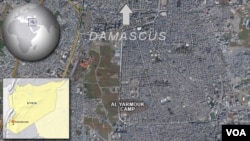Yarmouk was once the thriving capital of the Palestinian diaspora but has since become a site of suffering in the bloody Syrian conflict and a victim of a jihadist group onslaught earlier this month.
But for the hundreds of thousands, who fled from what the U.N.’s Secretary General Ban Ki-moon called “the deepest circle of hell” in Syria, Yarmouk was once home.
Set up by Palestinians displaced by the 1948 Arab-Israeli war, it grew to play a crucial role among the Palestinian diaspora.
But with every bomb dropped and every building destroyed, 26-year-old Amal is finding it harder and harder to recognize the place she used to love.
Amal spoke to VOA from Shatila, a Palestinian camp in Beirut, where she now lives with her sister Hanadi, 23, and husband Mohamed, 24.
Former Yarmouk resident Amal described the daily phone calls that they make to loved ones who remain trapped there.
“They don’t talk about the situation. They only say please forgive us, and remember that we love you,” said the 26-year-old.
“We can’t just chat. How can you make someone laugh when they are in this place? We just hope they know that really still in our minds there is a little hope that we still might see them.”
“But we can’t. We know it will never happen. Really, it will never happen.”
Located in a suburb close to the heart of Damascus, Yarmouk has been under siege by government forces since late 2012.
Aid agencies are often blocked from providing much-needed help and residents are often prevented from leaving.
Between July 2013 and late February 2014, nearly 200 of those living in the camp died, with 128 of these starving to death, according to Amnesty International.
It was during that period that both Amal and Mohamed fled the camp. They later met and married in Shatila.
Under attack
Since then, things have since gotten worse.
This month, the Islamic State and the al-Qaida affiliated group al-Nusra Front launched an attack on Yarmouk.
As well as carrying out beheadings, Islamic State's presence sparked further violence as it battled both Palestinian and Syrian government forces. The camp is strategically located in the south of Damascus, near rebel-held suburbs. It has become a valuable supply line to rebel fighters, and as a result, has been a victim of heavy government artillery strikes that have decimated large parts of the neighborhood.
U.N. aid supplies have since been cut off completely, leaving those trapped in desperate conditions.
“We believe that IS is still there and the worst is yet to come in terms of the humanitarian situation and conditions,” said Salim Salameh, head of the Palestinian League for Human Rights-Syria.
“Hell has become more hellish”, said Wesam Sabaaneh, a coordinator at NGO Jafra Foundation.
Sabaaneh was frequently in the camp helping give aid until the arrival of Islamic State, which tried to force the organization out.
“There is no water, food, medicine or electricity. “There is no safety. The people there are without hope,” he said.
Former haven
Though exact figures are disputed, around 1 million are thought to have lived in Yarmouk before the war began, of whom up to 170,000 were Palestinian.
Just a fraction remain, with 3,000 thought to have left since the attack by Islamic State this month . Other estimates place the remaining number between 18,000 and 6,000.
“It was special, as there was freedom of speech and a strong cultural life in which Palestinians could come and discuss politics and exchange ideas about the future of the Palestinian people,” Wesam Sabaaneh said.
Though some remain in Damascus, many Palestinian Syrians from Yarmouk have dispersed throughout the Middle East and beyond.
According to the U.N. half of Palestinian Syrians are internally displaced, with 45,000 now in Lebanon and 15,000 in Jordan.
“The fact that people are leaving attests to their [Palestinians] sense of regional vulnerability,” said UNWRA spokesman Christopher Gunness.
“They were once welcomed, and felt that this region was their home. Now there is this terrifying sense of vulnerability and fear.”
Reminiscing
It is a vulnerability that Amal, Mohamed and Hanadi are all too aware of.
In Shatila, they are beginning to start a new life, having found work. They also have built a small community of others who fled from Yarmouk.
But Lebanon is much different from their home in Syria. Here they face discrimination. And, in the wake of a recent state clampdown on allowing refugees into Lebanon, both Amal and Mohamed’s residency papers have expired, making them vulnerable to arrest.
A number of friends have left, risking their lives to be smuggled into Europe from Libya - a journey across the ocean to Italy and beyond.
Though Lebanon has its risks and dangers, Amal says there is no going back to Yarmouk.
“When I hear about Da’esh [another name for Islamic State] and what has happened in the last few months, I have no hope of getting Yarmouk back,” said Amal. All the good memories and things we used to love in Yarmouk camp are gone.”
“Why would I want it back? I want to destroy it,” she added, her voice cracking.
“I want to build it again with something clean, something pure.”









